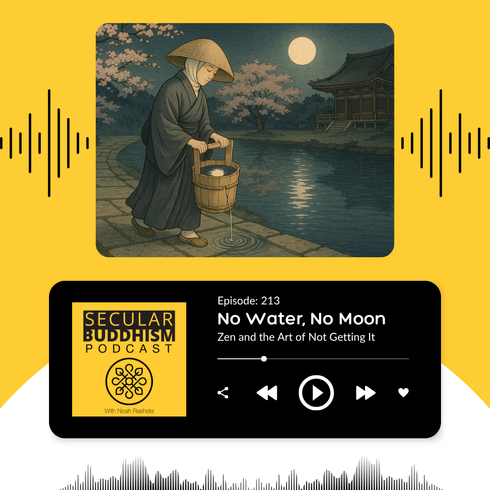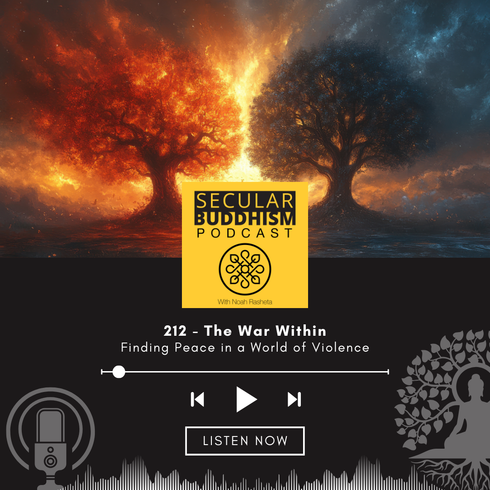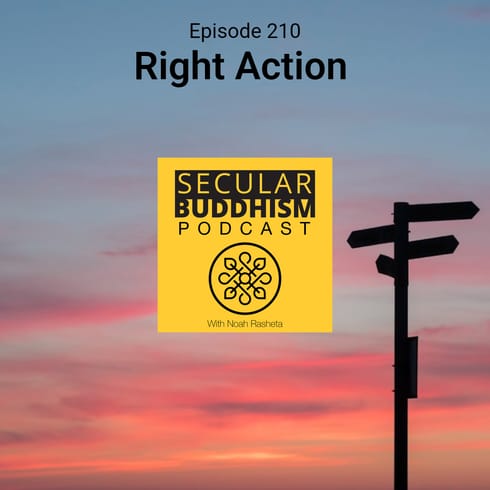
68 - Questions About Buddhism
In this podcast episode, I will discuss my newest book and I will share some of the specific Q&A’s directly from the book. Presented in a practical Q&A format, No-Nonsense Buddhism for Beginners is the most clear-cut introductory guide to understanding the essential concepts of Buddhism and how they relate to your daily life.
Subscribe to the podcast on:
iTunes – https://itunes.apple.com/us/podcast/secular-buddhism/id1071578260
SoundCloud – https://soundcloud.com/secularbuddhism
TuneIn – http://tunein.com/radio/Secular-Buddhism-p823114/
Stitcher – http://www.stitcher.com/s?fid=80132&refid=stpr
Transcription of the podcast episode:
Welcome to another episode of the secular Buddhism podcast. This is episode number 68. I am your host, Noah Rasheta and today I’m talking about questions about Buddhism.
When I started this podcast a few years ago I started to receive several e-mails with questions that people had to expand on a specific topic or to clarify a certain teaching and I’ve been answering these questions for quite some time, usually by e-mail. Then with the podcast being out, I was eventually approached by a publisher and I was offered the opportunity to write a book about Buddhism that just recently came out. It’s available for pre-order now on Amazon. The book is called, No Nonsense Buddhism for Beginners, Clear Answers to Burning Questions About Core Buddhist Teachings.
I’m really excited to have this book out because it’s formatted in a question and answer format and broken into four specific parts. Part one is questions about the Buddha, part two is questions around core concepts, part three has questions and answers around core teachings and part four has questions around core Buddhist practices. This book is intended for anyone who is new to Buddhism but also to help practitioners who are looking for a resource to be able to answer questions from friends or loved ones.
You may have noticed as you start to apply these concepts in your life, it’s common for people to say, “Oh, you’re interested in Buddhism? Well, what does Buddhism say about this or about that?” If you’re like me you’ve probably noticed that that is a common thing from friends and family. So this book serves as a good platform to be able to address some of these questions, to answer them in a way that people who are not familiar with Buddhism or any concepts around Buddhism would be able to understand the answers to some of those questions.
So I thought it would be cool to do a podcast episode to just quickly share with you some of the questions and answers from the book just to give you an idea about how this book works and what some of the questions are that are addressed and then of course, some of the answers. I thought I would go through and share at least one question from each part. In part one I address 16 different questions around the topic of the Buddha. Who was he? What language did he speak? Did he have a family? What happened to him? How did he die? All of these questions that center around the historical figure of the Buddha.
So I’ll give you one example. One question is who was the Buddha? Was he a real person or is he a myth? This is how I answered it in the book. I said Buddha is a title that was given to a man named Siddhārtha Gautama. Siddhārtha lived around 500 BCE in Northern India in what is now Nepal and generally when people refer to the Buddha, they are referring to Siddhārtha, the man whose teachings became the foundation of what we now call Buddhism. There’s little scholarly debate around Siddhārtha’s existence. However, there is some debate around specific events in his life. As is common with many ancient traditions, the historical Buddhist teaching have evolved into teachings about the teachings.
This opens up more room for individual teachers’ interpretations but it brings into question the historical accuracy of modern day re-tellings. However, we can still tell a lot about the Buddha by his teachings that have been passed down. We know that they center on two main themes. The problem of human suffering and the methods that can bring about the cessation of suffering. And the Buddha taught a method of living that tended to be practiced rather than a set of ideas he asked his followers to believe. His teachings, known collectively as the Dharma, invite us to look inward and study our own minds in order to gain a clearer understanding of ourselves and the nature of reality.
That’s how I answered that one specific question. Who was the Buddha? Was he a real person or is he a myth? Then there are 15 other questions in that section that all center around the topic of the Buddha. In part two where I start to address core concepts, the majority of what I’ve talked about as far as topics on the podcast I think would fall within this realm, core Buddhist concepts. I spend a lot of time discussing concepts. I haven’t spent hardly any time on the podcast talking about the historical figure known as the Buddha so I think all 16 of those questions in part one are probably going to be new to most podcast listeners unless you’ve been digging into studying Buddhism on your own from other sources.
But part two that has the core concepts, you may recognize some of these and here I address 19 questions and answers around core concepts. I want to share two of them with you because these may be kind of new. I don’t think I’ve done podcast episodes on this. Several of the ones that I bring up in this book may be new for you. One of the questions, what does Buddhism teach about good and evil? The way I answered that question was from the Buddhist perspective, good and evil are not inherent forces out in the universe. Instead they’re internal states of mind. Buddhism teaches us to look inward. There we can find the source of all the good things we say, think and do and likewise discover that we ourselves, our own minds, are the source of any evil. This understanding gives us a greater sense of responsibility over our own thoughts, words and actions.
Rather than thinking of evil as an external agent acting upon us, Buddhism teaches that greed, hatred and ignorance are the sources of what we typically think of as evil. In Buddhism these three qualities are called the three poisons or the three fires. The challenge the three poisons pose in our lives is that they drive us to look outside of ourselves to try to achieve happiness or to avoid suffering because external things like money, fame or power can’t bring us lasting joy or contentment. We’re setting ourselves up to experience unnecessary suffering by chasing after them. Material things can be nice to have for a time but the happiness and fulfillment we seek is not found in external sources. That was the answer I gave to the question what does Buddhism teach about good and evil. That’s one concept I address in the book.
Another one, a big question that people want to know is do Buddhists believe in reincarnation? This is how I answered that question. Buddhists believe in rebirth which is not quite the same thing as what you probably have in mind when you think about reincarnation. The traditional concept of reincarnation is that you, some kind of soul or spirit, go on to inhabit a new physical form whether it be a person, animal or plant. Though some Buddhist schools think of rebirth as something closer to this idea of reincarnation, it doesn’t fit with other Buddhists’ understanding of impermanence and non-self. We’re changing form every day, experiencing re-birth even from one moment to the next. The you that’s listening to this is literally not the same you who will be listening at the end of the podcast as the you that was listening at the beginning.
If there is no permanent you, which part of you could transcend death to become reincarnated? When we observe nature we see constant rebirth. After all the law of conservation of energy in physics states that energy can’t be created or destroyed. It can just be transformed from one form into another. A cloud changes form and becomes rain. The rain becomes part of a river, flows into the ocean and then gets heated up and evaporates into the air where it may become a cloud and start the process all over again. What was for a time a cloud is transformed into something new and we don’t say the cloud dies when it changes form into raindrops. Are we really any different from the cloud? When we die our bodies change form as they decompose and become part of nature but they never cease to exist.
Buddhists believe that humans, like everything else in nature, are part of a continual cycle of change. So that’s how I answered that question about reincarnation. You can imagine 17 other questions beyond the two that I just shared with you. I really go deep into a lot of these core Buddhist concepts. In part three of the book I talk about core teachings. I have 17 questions and answers that I address in this section and I’ll just share one of them. The question I received was, “It seems like “I” am the source of a lot of important things. Awareness, suffering, good and evil. What else can Buddhism teach me about the nature of myself? What makes me me?”
This is how I answer that question. According to Buddhist teachings our “self” is a perspective. It is a product of our perception. Our sense of self is an event that occurs rather than a thing that exists. Imagine pausing a movie to see a single still image. Every film is made up of those individual frames but when we watch movies, we perceive them as one continuous moving image telling a connected story. Ourselves are like the film strip. A collection of unique still frames that are generated in each moment-to-moment experience of being alive. If you could pause time and see the individual frame in this specific moment, you would see that it’s slightly different from the ones just before and after it. In other words, the you of right now is not the same you of the previous moment.
The Buddha taught that we are made up of five components that come together to create the perception of a distinct individual I or me. These five components are called the five skandhas, a Sanskrit word meaning aggregates or heaps. The five aggregates are form, sensation, perception, mental formations or thoughts and consciousness. On this subject the Buddha furthermore taught that we sense reality in our world through six sense organs. The eyes sense visible form, the ears sense sound, the nose senses odor, the tongue senses taste, the body senses tangible things and the mind senses thoughts or ideas. You’ll notice that the first five senses are the ones we’re all taught in school but Buddhism also considers the mind to be a sense organ since our minds sense thoughts and ideas.
So that’s how I answered that question but then I go on to answer because the follow-up questions ask about the specific five aggregates so I have five different questions centered around each of the five aggregates. I won’t share that here but in the book you would certainly get a lot more information on the five aggregates than what I just shared. And then in part four, the final part of the book, I talk about core practices. Again, practices are not really addressed in the podcast. The podcast almost exclusively addresses Buddhist concepts, core concepts. Part one, part three, teachings, you get a mix of that in the podcast and part four, practices, those are going to be all unique topics that I’ve never really gone into on the podcast.
One of the questions that I address in part four is the question everybody talks about meditating and the Buddha found enlightenment through meditation so it seems like an important practice. But how do you do it? Is there a correct Buddhist way? I guess I’m going to go back for a second because this is a topic that’s addressed in the podcast but this is how I answered that question. There are countless meditation techniques and methods taught among the various schools of Buddhism. Some schools of Buddhism don’t practice meditation at all. One of the most common techniques is mindfulness meditation. The goal of this technique is to learn to become an observer of the world and our own experiences.
We spend so much of our time in thinking mode, ascribing meaning to our thoughts and emotions. We chase after thoughts with other thoughts or try to control our thoughts which only aggravates the overall problem of being habitually reactive. Mindfulness meditation helps us break out of the cycle of reactivity. The technique can be as simple as observing your breath. Notice what it feels like to breathe. Can you feel the slight temperature fluctuations at the tip of your nose between the in breath and the out breath? Do you notice the subtle rise and fall in your chest, shoulders or abdomen with each breath? When we observe we pause our reactive thinking and stop making meaning.
For example, when we’re sitting outside watching the clouds float by, we don’t have the tendency to ascribe value to the shapes that we see. We don’t think, “Oh, this is a good cloud or that’s a bad cloud. This cloud isn’t puffy enough or that cloud is too tall.” In these moments of observation we just see the cloud for what it is. When we turn this process inward, we can start to experience the same unbiased, nonjudgmental attitude toward our own thoughts and feelings. Suddenly we’re not judging our anger as good or bad. We just notice that we’re experiencing an emotion and allow it to remain without resisting it or trying to fight it off. Before we know it, the emotion will dissipate or be replaced by another just like the clouds in the sky.That’s how I answered the question about meditation.
Now under core practices I’ll talk about several Buddhist practices from chanting to meditation, 12 different questions and answers in that section. The book overall has 64 total questions and again, these are questions that I’ve collected in the years of having the podcast and teaching workshops. I’m really excited to present this book, somewhat as an introduction to Buddhism. It’s like the title suggests, Buddhism for Beginners, but really it’s for anyone who’s interested in understanding what the core Buddhist concepts and teachings are and practices and then of course, who was the Buddha and all the questions centered around the historical figure that we know as the Buddha.
It’s a book that I think would be really helpful for any practitioner who’s wanting to have a deeper understanding of these concepts. That’s where I was at the beginning of all this, my journey with Buddhism. What I found was Buddhist practices were really helpful, specifically meditation. It was really working for me. It was helping me to find peace in my life and I wanted to understand where does this come from? Who came up with this? Why does this work? That journey of trying to understand meditation as a practice led me to study and understand with greater depth Buddhism in general.
That’s my attempt with this book is to kind of take in a question and answer format all of that information and make this easy and accessible for you as the reader or for anyone who may approach you with questions about Buddhism. So that’s the goal there. One of the things I do plan on eventually doing with this book is having … You know, I’ve traveled around and done these workshops, one-day workshops where it’s an introduction to mindfulness or an introduction to Buddhism. There are limitations with doing that because if I’m going to travel somewhere there are expenses associated with that. I have to get there so I have to charge to do these workshops.
Well, I’m really excited to announce that my next project now that this book is over, is to launch an online workshop that will be available for free for anyone who is interested in learning about this stuff. This book will serve as kind of a book to accompany that workshop. That’s something that’s on the horizon. I’ll announce more about that as it gets closer, as I have dates lined up for that. But for now the main thing I wanted to do was just introduce you to this book, give you an example of some of the questions and answers that are addressed in the book and let you know that there are 64 total questions there that if you’re interested in hearing, you can learn about them.
You can visit secularbuddhism.com where you’ll see the link there for the book or you can visit everydaybuddhism.com. That is a URL that links directly to the book, makes it easy to remember. So secularbuddhism.com you’ll find it, everdaybuddhism.com you will also find it. That’s all I wanted to share for today. If you enjoyed this podcast episode, please share it with others, write a review, give it a rating in iTunes. If you would like to join our online community you can visit secularbuddhism.com/community and that’s all I have for now. I look forward to recording another podcast episode very soon. Thank you and until next time.




